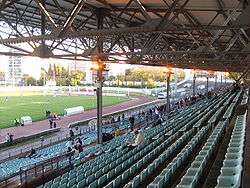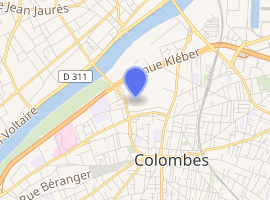Stade Olympique Yves-du-Manoir
The Stade Olympique Yves-du-Manoir (also known as the Stade Olympique de Colombes, or simply Colombes to the locals) is a rugby, track and association football stadium in Colombes, near Paris, France.
 | |

| |
| Former names | Stade du Matin (1907–1919) Stade de Colombes (1920–1924) |
|---|---|
| Location | Colombes, France |
| Capacity | 14,000[1] |
| Surface | Grass |
| Opened | 1907 |
| Tenants | |
| Racing Club de France Football Racing 92 (1907–2017) | |
Named in memory of French rugby player Yves du Manoir in 1928, it was the main stadium for the 1924 Summer Olympics and had a capacity of 45,000 at the time.[2] During the 1924 games, it hosted the athletics, some of the cycling, some of the horse riding, gymnastics, tennis, some of the football, rugby, and two of the modern pentathlon events (running, fencing). The Olympic races involving Harold Abrahams and Eric Liddell which are portrayed in the film Chariots of Fire were run here, although the stadium was not used for the film.[3]
It was later expanded to a capacity of over 60,000. Colombes was also the venue for the 1938 World Cup Final between Italy and Hungary, and also hosted the home team's two matches in the tournament.
Colombes hosted a number of French Cup finals and home games of the French national football and rugby union teams into the 1970s. It remained the country's largest stadium until the renovated Parc des Princes was inaugurated in 1972. By that time, Colombes' capacity had dropped to under 50,000 due to more stringent safety regulations. The national rugby union team played its last game at Colombes in 1972, and the national football team last played there in 1975.
French professional football team RC Paris used Colombes as their home ground until 1985 or so, then moved on to other stadia before coming back in the 2000s.
Unlike RC Paris, Racing 92 rugby did not leave Colombes until November 2017. They originally planned to redevelop Yves-du-Manoir into a 15,000-seat stadium to be shared with Racing Club de France Football, but instead built Paris La Défense Arena in nearby Nanterre, playing their first match in the new venue in December 2017.[4] It remains to be seen whether the Racing Club de France football club will move as well.
The stadium was portrayed in the 1981 film Escape to Victory starring Sylvester Stallone and Michael Caine, but the stand-stadium used in the filming was the Hungária körúti stadion in Budapest, Hungary.
It is slated to be a field hockey venue for the 2024 Summer Olympics.
1938 FIFA World Cup
Stade Olympique Yves-du-Manoir hosted three games of the 1938 FIFA World Cup, including the final.
| Date | Time | Team No. 1 | Res. | Team No. 2 | Round | Attendance |
|---|---|---|---|---|---|---|
| 5 June 1938 | 17:00 | 3–1 | Round of 16 | 30,454 | ||
| 12 June 1938 | 17:00 | 1–3 | Quarter-final | 58,455 | ||
| 19 June 1938 | 17:00 | 4–2 | Final | 45,000 |
References
- "Stade Yves Du Manoir". Racing Métro 92. Archived from the original on 6 December 2013. Retrieved 6 December 2013.
- 1924 Olympics Official Report. pp. 50–5, 96, 121, 152, 216, 222, 238, 248, 318, 339, 375, 499, 503, 536. (in French)
- "The Real Chariots of Fire," (TV Movie) Silver River Productions (2012)
- Escot, Richard (16 October 2017). "Le nouvel écrin du Racing 92, la U Arena, ouvre ses portes". L'Équipe (in French). Retrieved 17 October 2017.
External links
| Wikimedia Commons has media related to Stade Yves du Manoir (Colombes). |
- Colombes Stadium Yves-du-Manoir in postal card (in French)
- History of the Olympic Stadium (in French)
- Article: Chariots of Fire stadium reprieved
| Preceded by Olympisch Stadion Antwerp |
Summer Olympics Main Venue (Stade de Colombes) 1924 |
Succeeded by Olympisch Stadion Amsterdam |
| Preceded by Olympisch Stadion Antwerp |
Olympic Athletics competitions Main Venue 1924 |
Succeeded by Olympisch Stadion Amsterdam |
| Preceded by Olympisch Stadion Antwerp |
Summer Olympics Football Men's Finals (Stade de Colombes) 1924 |
Succeeded by Olympisch Stadion Amsterdam |
| Preceded by Stadio del PNF Rome |
FIFA World Cup Final Venue 1938 |
Succeeded by Estádio do Maracanã Rio de Janeiro |

_pictogram.svg.png)



_pictogram.svg.png)



